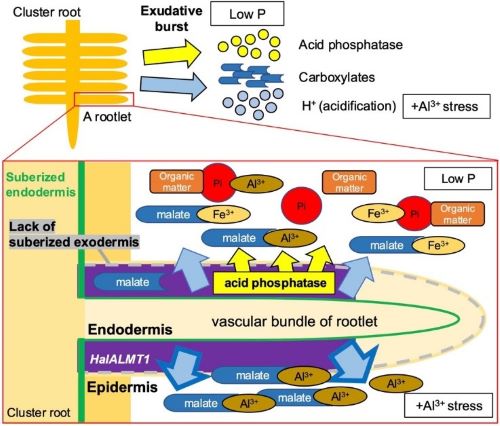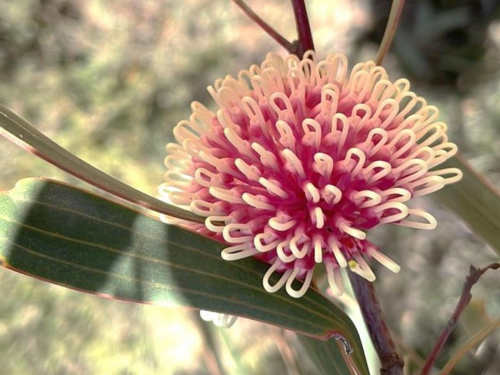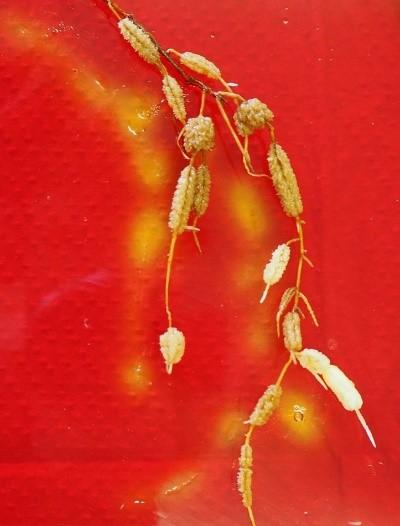Joint press release by Hiroshima University, The University of Western Australia, Hokkaido University, Okayama University, and Yamagata University.
Plants require phosphorus to grow and survive. In environments with low levels of available soil phosphorus, plants need to adjust to stay alive.
Hakea laurina, or pincushion hakea, is a shrub native to southwestern Australia, best known for its beautiful pincushion-shaped flowers. (Photo courtesy of Hans Lambers, The University of Western Australia)
The pincushion hakea is a large woody, evergreen shrub native to southwestern Australia, an area that has amazingly low levels of soil phosphorus. This plant has adapted to these conditions by forming cluster roots—a large number of smaller rootlets extending from the root axis that resemble a bottlebrush—to extract the small amount of phosphorus in the soil.
Cluster roots help plants in low-nutrient soils by increasing the amount of root surface area in contact with the soil, improving their ability to extract limited resources. Additionally, cluster roots secrete chemicals and enzymes to enhance the bioavailability of nutrients, primarily phosphorus, in the soil. Acid phosphatase, for example, is an enzyme secreted by cluster roots that converts organic phosphorus into a form that plants can readily absorb. Improved understanding of these survival mechanisms could ultimately help researchers develop food crops that can thrive in nutrient-deficient soils.
While researchers have successfully identified many of the chemicals secreted by cluster roots to improve phosphorus availability, the genes and molecular pathways responsible for cluster-root secretion and uptake in the Proteaceae plant family, including pincushion hakea, had not been identified. In order to better understand how cluster roots function at a molecular level, researchers from Hiroshima University, The University of Western Australia, Okayama University, Hokkaido University, Yamagata University and other institutions collaboratively performed an RNA-Seq experiment on pincushion hakea to identify the genes expressed in its cluster roots.
The team published their research on February 24 in the journal New Phytologist.
The cluster roots of Hakea laurina, adapted to help the plant survive in severely nutrient-poor soils. (Courtesy of Hirotsuna Yamada, Hiroshima University)
“Our main question was: How does the pincushion hakea, Hakea laurina, survive in its extremely phosphorus-limited environment? Our hypothesis was that Hakea laurina has distinct strategies to maximize the release of root exudates, such as carboxylates and acid phosphatases, from its cluster roots, which are important for enhancing soil phosphorus availability,” said Dr Hirotsuna Yamada, assistant professor (special appointment) at the Graduate School of Integrated Sciences for Life at Hiroshima University and first author of the research paper.
The researchers compared the genes expressed in mature cluster roots to those in adjacent lateral roots as a control. This comparison identified 4,210 genes that were expressed at higher levels in cluster roots, providing a large number of prospective genes associated with increased cluster-root secretion and absorption. These included phosphate transporters involved in phosphate uptake into the root and acid phosphatases. Additionally, Kyoto Encyclopedia of Genes and Genomes (KEGG) pathway analysis indicated these cluster roots enhanced carboxylate metabolism, which would support an increase in the supply of the carboxylates malate and citrate for secretion into low-phosphorus soils.
One of the highly expressed genes in pincushion hakea cluster roots was an aluminum-activated malate transporter (ALMT) protein that the researchers identified as HalALMT1. This HalALMT1 shares 51% of its deduced amino acid sequence with LaALMT1, a Lupinus albus (white lupin) malate transporter that secretes malate into the soil and thus enhances phosphorus availability. Electrophysiological assays and overexpression in Arabidopsis thaliana established that HalALMT1 mediated malate release into the soil. Its activity was further enhanced in the presence of aluminum, which can be toxic to plants in acidic soil. These results suggest that HalALMT1 helps to both mobilize phosphorus and reduce aluminum toxicity to plants through malate secretion.

Hakea laurina exhibits an exudative burst of acid phosphatase and carboxylates (malate and citrate) and H+ release with low-phosphorus (P) availability, which increases the Al3+ concentration in the soil. Aluminum-activated Malate Transporter 1 in Hakea laurina (HalALMT1) is transcriptionally upregulated in the cortex of mature cluster rootlets, facilitating malate release under low-P conditions. The malate transport activity was further enhanced by exposure to Al3+, which may occur in acidic soil. The activity of acid phosphatase was particularly strong in the apoplast of the cortex. Hakea laurina develops a suberized endodermis, but not a suberized exodermis, in cluster rootlets, which may facilitate malate exudation and acid phosphatase release from the cortex into the rhizosphere. (Adapted from Yamada et al. (2025), New Phytologist, CC BY 4.0)
The researchers also found a unique expression pattern of HalALMT1 in cluster roots that further contributes to survival in phosphorus-deficient soil. “Our results show that cortex cells in the cluster rootlets of Hakea laurina are sites of carboxylate and acid phosphatase secretion, potentially facilitating a rapid release of root exudates. The absence of a suberized exodermis, a diffusion barrier, further enhances this trait, offering novel insights into plant adaptations to phosphorus deficiency,” said Dr Jun Wasaki, professor in the Graduate School of Integrated Sciences for Life at Hiroshima University and senior author of the research paper.
While the discovery of a new secretion pathway in cluster roots has significantly contributed to the field’s understanding of plant survival mechanisms, additional questions remain. “It is essential to gain a comprehensive understanding of the formation and physiological functions of cluster roots, as well as to identify the key factors that regulate them, to apply the exquisite phosphorus-acquisition strategies of cluster roots to crops. Our research team plans to further advance the understanding of cluster roots with the goal of applying this knowledge to crop improvement,” said Dr Yamada.
This paper received funding from Hiroshima University to cover open access fees.
About the study
Journal: New Phytologist
Title: HalALMT1 mediates malate efflux in the cortex of mature cluster rootlets of Hakea laurina, occurring naturally in severely phosphorus-impoverished soil
Author: Hirotsuna Yamada, Lydia Ratna Bunthara, Akira Tanaka, Takuro Kohama, Hayato Maruyama, Wakana Tanaka, Sho Nishida, Tantriani, Akira Oikawa, Keitaro Tawaraya, Toshihiro Watanabe, Shu Tong Liu, Patrick M. Finnegan, Hans Lambers, Takayuki Sasaki & Jun Wasaki
DOI: 10.1111/nph.70010
Related faculty members
Media Contact
Inquiries on the study
Jun Wasaki
Professor, Graduate School of Integrated Sciences for Life, Hiroshima University
Email: junw * hiroshima-u.ac.jp
Hirotsuna Yamada
Assistant Professor (Special Appointment), Graduate School of Integrated Sciences for Life, Hiroshima University
Email: hirotsunayamada * hiroshima-u.ac.jp
Hans Lambers
Emeritus Professor, School of Biological Sciences, The University of Western Australia
Email: hans.lambers * uwa.edu.au
Toshihiro Watanabe
Associate Professor, Faculty of Agriculture, Hokkaido University
Email: nabe * agr.hokudai.ac.jp
Takayuki Sasaski
Associate Professor, Institute of Plant Science and Resources, Okayama University
Email: tsasaki * okayama-u.ac.jp
Keitaro Tawaraya
Professor, Faculty of Agriculture, Yamagata University
E-mail: tawaraya * tds1.tr.yamagata-u.ac.jp
(Note: Please replace * with @)
Inquiries on the story
Public Relations Office, Hiroshima University
E-mail: koho * office.hiroshima-u.ac.jp
Simone Hewett (Media and PR Manager), The University of Western Australia
E-mail: uwamedia * uwa.edu.au
Public Relations & Communications Division, Office of Public Relations and Social Collaboration, Hokkaido University
E-mail: en-press * general.hokudai.ac.jp
Public Relations Division, General Affairs Department, Okayama University
E-mail: www-adm * adm.okayama-u.ac.jp
Secretary’s and Public Relations Office, Yamagata University
E-mail: yu-koho * jm.kj.yamagata-u.ac.jp
(Note: Please replace * with @)

 Home
Home

















